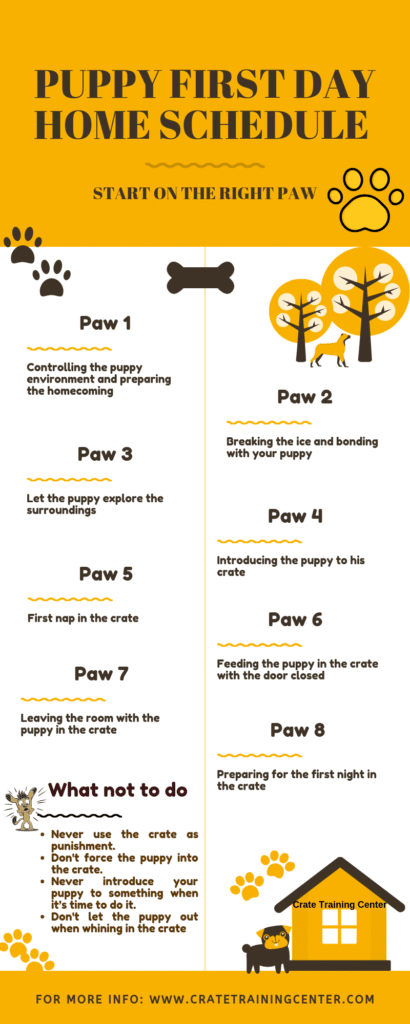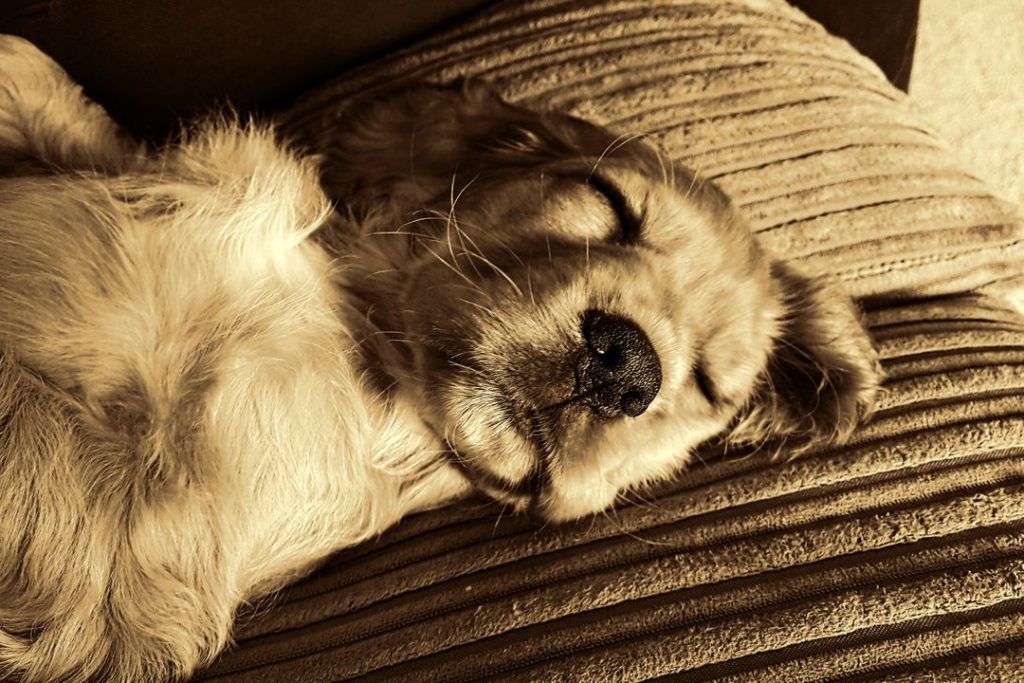Bringing a puppy home the first night is a huge and exciting moment for you, the puppy, and the family (that includes other dogs or pets at home).
Now you have to face your first challenge which is how to deal with crate training your new puppy the first night.
Rest assured this article will serve as a complete step-by-step beginner’s guide to present you with the best tips and steps to go through your first night smoothly and boost that relationship from the start.
If you follow these easy steps you’re going to do just fine and enjoy your first few days with the family’s newest member.
In this article, we will be looking at these 8 easy simple to do steps, to plan your first night.
We will be going over your first-day schedule to start crate training your dog.
We also going to be answering the most asked questions about that first night we’ve also had when having a new puppy.
Last but not least an easy to share info-graphic about the 8 steps will be provided at the end of the article so stick around.
So let’s start with the most basic question that needs to be answered before going through with the first-night crate training program.
4 unanswered questions about crate training puppy first night
Should you crate your puppy the first night?
The most direct answer would be definitely YES, crate training a puppy first night is a must, and here is why.
The puppy’s sleep time, especially on the first night, is an intimate time, so he needs his little den where he can feel safe and have some privacy.
Crate training a puppy helps greatly with the communication building phase.
You also want to start your puppy home training on the right foot.
And for that, I recommend two things get a wire crate with a divider like this one (click to check the price on Amazon) and this plush dog toy and you can check how to use and what are the different types of dog toys in this article.
At some point you are going to need to crate train your puppy, sure crates aren’t for every dog but a crate is great for travel, for outdoor activities, for having your dog close by around people without actually having to watch him all the time. So why not start with it the first night while you’re establishing that long-term relationship.
Now, let’s head over to the next question.
Where should your puppy sleep the first night?
Puppies during the night
By now we’ve already established that your puppy needs to be in a crate on his first night so he can feel safe and secure.
Now, where do I put the crate at night? Should I keep it close in my room or just outside? Or can I crate him away on the first night?
Bad news alert! No, it’s minor and temporary so just relax.
What you should know is that small puppies have a hard time controlling their bladder, so just like having a baby you will need to wake up once or twice to let your puppy out to a relief area.
Where you actually need to place the crate
For you to be able to hear your puppy when he starts crying at night to pee, you should have his crate close at night preferably in the room for some more insurance feeling you around or at least in the hallway just outside your bedroom.
Dogs are fairly clean animals, so they won’t pee where they sleep unless they have to, so you really want to relief your dog at night not to pick a bad habit of peeing in his crate.
It is going to be a bit annoying the first night to have the puppy in the room because they will probably start whining at times during the night.
A puppy whining in the crate at night is something you should expect especially those few first nights. So that leads us to our next logical question.
How do you get a puppy to stop whining at night?
Eliminate confusion

The first important thing to know is that whining and crying is yet the only way a puppy knows to communicate, at least until you establish a good communication base.
Knowing why your puppy is whining is a very important thing to know as it allows you to prevent your puppy from developing bad habits.
As we said earlier your puppy won’t probably make it through the night without potting – depends on the breed – so to limit those relief trips you want to take your puppy pot just before settling down for the night.
You also want your dog to be down on his energy when he goes in the crate for the night, so you want to have some playing sessions, take him out for a potty trip then another playing session and again take him for his final relief just before bedtime.
Another important tip is to stop giving your dog water two hours before his sleep time so we can reduce the need to go out at night.
Stand your ground
Do you want to know how to make a puppy stop crying at night? just ignore it.
Now that we know the puppy has no reason to cry in the crate you should just ignore the initial protest whining which is totally normal.
If you do make a great effort to make the crate a pleasant place for your dog you are less likely to have these crying issues.
Don’t worry we are going to be showing you exactly the steps to follow to achieve that perfect initial interaction with the crate.
Another important piece of advice is not to play or cuddle the puppy when taking him out at night for potty breaks, keep it all about the break and you can reward with treats and get him back to the crate.
If you play with the puppy while taking him for his potty break he will associate whining and crying to getting what he wants.
So as we said it’s all down to making the crate a pleasant place and that leads us to the next question.
Puppy first night light on or off?
The answer to that question would be a big NO; you want your puppy to get used to his new home as soon as possible, so we want him to be in normal circumstances.
You can’t have your puppy used to the light on and then 4 weeks later you’re tired and want the lights off at night, and now your puppy is showing resistance and you have to start over.
This goes on almost anything you want your dog to be doing, just put in the effort in the first days or no matter how it takes, and then you can relax knowing your puppy is just set up and enjoying life like you want him to.
What should I put in my puppy’s crate at night?
Many questions arise within this same question, do puppies need water at night? Should I leave water in the dog crate at night? Can I leave food or maybe toys in the crate?
Well previously we’ve seen that the puppy will probably need to pee at night, as a result, we need to stop watering him two hours before going to sleep, which indicates that leaving water in the crate isn’t the best idea, also, puppies are playful animals and may just make a mess with them.
The same thing goes with food; puppies don’t need to eat at night if fed enough before they settle down.
You want to leave a toy that the dog enjoys in the crate so that he can associate the crate with a more joyful experience.
You also want to avoid putting a blanket in the crate as the puppy may just pee on it. You can install one on the crate or have a crate cover if it’s a metal crate if it’s a plastic one no cover is needed.
Now that we have covered all the questions that you may have about crate training your poppy for the first night, we can move on to elaborate our easy to follow 7 steps program to go through our first night in the crate.
8 easy to follow steps to crate training puppy the first night
Step 1: Controlling the puppy environment and preparing the homecoming
You most certainly want your puppy’s first day home to be perfect to start bonding and diving into that long-term relationship.
So the first important thing to be thinking about is preparing a safe environment for the puppy to come.
Make no mistakes having a new puppy at home is no joke, they are time-consuming demanding little animals.
If you have some chores to do or anything really important to do you better do it the day before.
Puppies are curious animals that explore their surroundings by mouth, meaning you don’t want any incidents on your first day. What that means is to prepare a safe Puppy proofed area.
Leave nothing that your dog can swallow or can scare him, nothing fragile…
If you do have other dogs or animals at home you want to secure them before letting the new four-legged family member play around.
Having the puppy on the leash throughout the first day is necessary; you need that house line to keep him supervised at all times. New puppies tend to sleep a lot so that won’t consume much of your day if you’re successful with the crate introduction.
Step 2: Breaking the ice and bonding with your puppy

You just got blessed with a puppy and this is his first day home, probably you’re super excited and want to start playing on the spot.
You may want to break it down a bit give it a moment to let your lovely puppy feel a little safe, this is new for him probably misses his mother, doesn’t know where he is or what to expect.
When you go on a trip as a tourist you probably want to take some time in your hotel before going out exploring the perimeter, so it’s a bit similar here.
Let Your puppy sense that this is not a bad place, let his guard down, typically you want him exploring the place a little try to keep him close a little affection would be great.
Try using treats walk him around in an open space, the less noise or sudden moves there is the easier for the puppy to feel safe and loosen up.
Crate training your puppy on the first night isn’t an impossible task, however, you can’t just jump to it as soon as the puppy steps foot in the house.
Step 3: Let the puppy explore the surroundings
Letting the puppy explore the environment his going to be living in is a key element and an important step into having successful home training.
You want to be supervising the puppy all the time, hence the “prepare for the homecoming step” having the puppy on a leash is a must.
The safe line as we can call it helps you control the puppy’s movement around and keeps you one step ahead if he’s doing something you don’t like so you can avoid yelling and scaring him.
You want to regularly take your puppy to his outside potting area so he familiarizes himself with it, to avoid potting incidents inside.
Puppies can’t hold it for long so be vigilant with his need for relief.
Step 4: Introducing the puppy to his crate
Approaching the crate
If there is one thing to remember from this article, it’s to never introduce your puppy to something when it’s time to do it.
Always have your dog explore the thing you want him to do, and then gently walk him through it, it works with baths, have the dog around water then maybe use a towel for a little sponge bath.
Use the dog’s natural curiosity to your advantage and reward once he offers to do it on his own as soon as he does.
The same thing goes with crate training a puppy especially on the first night, let the dog walk around the crate, it would be perfect if it’s a double door crate so he has an open area to explore.
Never use a much larger crate than the actual size of the puppy; you can use large crates with a separation panel to limit the size.
Associating the crate to a happy time
Toss some treats in the crate to lure the puppy inside once he is inside, reward him instantly, and use verbal praise, repeat this for a few minutes and make sure to secure the door open not to scare him.
Make sure not to force the puppy to get inside, the crate must never be associated with violence nor unpleasant experiences.
Don’t overdo it, have breaks where you exercise and play, you want the dog to understand that the crate is a place to relax.
Puppies tend to sleep a lot as we said so after a while playing take him out for a pot and let him nap in the crate with the door open.
Feed the puppy in the crate so he associates it with food, and reward him often inside.
You may want to check Pavlov’s dog experiences about behavioral conditioning.
You can secure a chewing toy inside so he can chew on in there before he sleeps.
Step 5: First nap in the crate
This is a continuation of the previous step, having the puppy test the crate with no pressure, trying his first nap in it with the door open.
New puppies usually sleep for long periods during the day pretty much like a baby, so you have to jump on it to have the first nap in the crate.
Before nap time have the puppy exercise so he can be tired and sleepy but with caution, puppies, when excited, can keep on playing even if exhausted.
When you sense that your lovely puppy is tiered enough and sleepy, lure him with a treat to the crate and have a chewing toy secured in there so he can’t just grab it and go, also better if you have a blanket inside.
Having done a great job making the crate a happy place you probably won’t have any trouble getting the puppy to nap in it.
Don’t forget that the crate’s door is open, so you have to keep an eye on your puppy for when he wakes up. You want to repeat this process of playing in the crate and around it feeding in it and taking a nap throughout the day.
Step 6: Feeding the puppy in the crate with the door closed
Now that we’ve established a little attachment to the crate, you want to start testing closing the door while the puppy is inside.
The best time to start testing is when the puppy is feeding inside the crate, have his bowl in the other end opposite the door and once he’s feeding slowly close the door with no sudden movement.
You don’t want to rush into leaving the room while the crate’s door is closed even if the puppy seems to relax, just sit by the crate while eating, and once he’s done and wants out, open the door and reward.
Do this process again, but this time keep the puppy with the door closed a few minutes after he finishes the meal.
If the puppy starts whining don’t open it until he is calm or else that’s what he is going to do every time he wants out.
Step 7: Leaving the room with the puppy in the crate
If things are going as planned and the puppy is sitting calmly in the crate with it closed, you should be able to move around the room tossing a treat once a while encouraging with verbal praise.
Now just go ahead and leave the room for a few seconds and see how he reacts:
If the puppy is concerned and starts barking or whining, you want to slow it down a bit stay in the room give treats, and don’t stress over it puppies are different some may spend a few hours to get used to the crate others may take longer.
Just repeat the process and have the puppy moving around and exercising so he is more likely to just sit down and rest.
If the puppy is still chilling in his crate even with you out of his sight, congratulations you are set for a relatively peaceful night since the puppy will need to go for a potty break during the night, but you won’t be hearing any whining just to get out of the crate.
Step 8: Preparing for the first night in the crate
Before going to the crate for the night
Now all the steps we’ve seen before come down to this final and most important one; Preparing for the first night’s of sleep in the crate.
By now your puppy has established some sort of a happy relationship with the crate, been fed there had a great toy in there had plenty of treats inside and if things went as planned even had a nice nap and some alone time in there.
The first thing you want to do is eliminate any sort of complaints your dog may have during the night that may confuse you if he is whining.
You don’t want your dog to wake up 5 minutes after you’ve put him to sleep for a potty break, so you want to take him out just before bedtime for potty break.
You also want to stop watering the puppy around two hours before his bedtime to minimize potty breaks during the night.
In order to put down his energy, Exercise your puppy and have some playtime just before bed.
Place the crate preferably in your bedroom so as a result the puppy may sense your presence or at least close by the door where you can hear him when he wakes up for a potty break.
Let a toy in there and don’t put any blanket inside the crate or anything your puppy may pee on.
You can cover the crate with a blanket or a crate cover there are ones that match the crate itself, for more intimacy.
After getting in the crate at night
When you hear your dog barking or whining in the crate during the night you don’t want to let him out while he is whining, just let him calm down once it’s done reward him and then take him for a potty break.
Keep the potty break to its minimum interaction, in other words, no playing no cuddling just potting once it’s done put him back into his crate.
If the puppy is crying to be let out and you are 100% positive it’s not for a potty break, then just ignore him.
You cannot let the puppy out when crying or else it will be a permanent problem as the puppy will know that long whining will get him what he wants.
Don’t yell at your dog if whining in his crate just ignore it, it usually takes a few minutes max and he’ll be asleep again. Young puppies do fall asleep a lot.
If things go as planned you may have to wake up once or twice at most by night.
Make sure you follow these steps for a few days and you’re set for peaceful nights in no time.
Once your dog is used to sleeping in his crate, you can place it anywhere you want in the house.
As they grow puppies will learn to control their bladder, and you won’t need to wake up for potty breaks anymore.
The intelligent use of the crate can help you home-train your dog effectively and give him the safe intimate den he needs to relax and give you the peace of mind you need.
I would recommend that you read this article about tips for crate training a puppy during the day.
Here is an info-graphic you can share with your puppy-loving friends.








I love the step by step outline … lots of detail … everything is covered here …